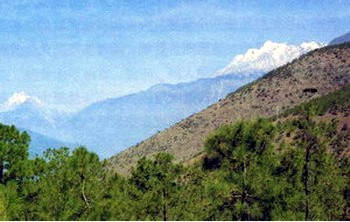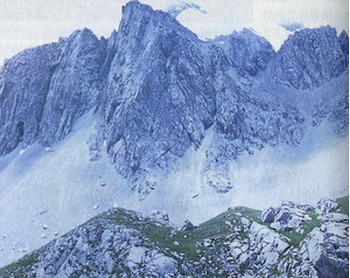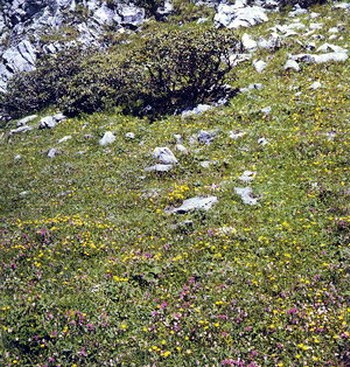Climb the Snow-Capped Yulong Mountain
LI Mingsen
We finally waited for the opportunity to climb the Yulong Mountain, after going over the piedmont on overcast and rainy days. On the morning of July 22, 1981, we drove to the Yuhu village, 20 kilometers away from Lijiang city. Located at the foot of the mountain, this village was 2700 meters above sea level, and it was the main door up to the Yulong Mountain.
At about 10 o'clock, we left the village and went northwards to the Yulong Mountain, following the horses carrying luggage and equipments. To the north of the village, there was a wide and inclined fan-shaped land, covered with weeds and huge stones. Through glacier terminal moraine, entering into a cavity, we took a small path, which was scoured out by the stream and trod by people and livestock, to climb up. The soil here had the same section as the red earth in the Lijiang basin. Both of them were developed by the same red ancient weathering shell substance. However, because the forest vegetation provided much organic matter and wet environment, the colour of the soil turned into maroon, belonging to red brown soil, which showed that there was an obvious change in vertical landscape with the increase of the altitude. The higher we climbed, the cooler we felt. The mountain breeze was swaying our soaked coats and we felt a little bit cold. The vegetation along the path throve better at this altitude compared to that at the foot of the mountain. Due to long-term cutting and grazing, virgin forest was rarely seen, but only secondary Yunnan young pine, quercus shrub and small amount of cuckoo were scattered around us. It was a pity that we missed the florescence and did not see the blooming azalea.
When climbing to a height of 3100 meters, we found that there was a small lawn encircled by pinewood. Then, we sat on the ground and took a rest. The guide told us that it was named as Bitter Buckwheat Dam. Over 200 years ago, buckwheat was planted in this area, but at this moment, it became a stretch of wasteland as well as a place for the travelers to have a rest.
After leaving Bitter Buckwheat Dam, we climbed a steep hillside and reached a larger low-lying lawn, where three precipitous cliffs stood high, shaped like a hollow of a horse’s hoof. We guessed that it might be an ancient cirque relics or a glacial erosion depression. Here it was 3300 meters above sea level. We could see that Yunnan pinewood was succeeded by cold-resistant dragon spruce and fir forest. The soil here was not brown earth as that at Bitter Buckwheat Dam, while it became grayish brown earth with more organic matter. Affected by human activities as Bitter Buckwheat Dam, we could not see virgin forest on this low-lying ground except bushes and weeds. However, what surprised me was the uncountable bloodsuckers—the leeches on the land. So here was the place of “Leech Dam” that we had heard of at the foot of the mountain. Some colleagues of mine felt frightened, but I did not care about this litter unlovely creature, because I had seen them in Tibet’s Medog Grand Canyon and Mount Qomolangma. We removed those leeches from the clothes and crossed this terrible leech dam as fast as we could. When we climbed to a slope higher than the leech dam by 200 meters, we felt relaxed, because there were not so many leeches. Moreover, we found a stream available for drinking, and we camped here.

Photo1. A distant view of snow-capped Yulong Mountain
When we fell into a profound sleep, we suddenly heard the rolling of thunder, then the heavy shower fell on the tent. Somebody cried out: leeches are coming! The sleepiness disappeared before I stood up to look over. After a while, I lay down again, but could not fall asleep. Tossing and turning restlessly, I spent the first unforgettable night on the Yulong Mountain.
 |
| Photo2. The landscape of snow-capped Yulong Mountain |
On the next morning, the sky was clear and the air seemed extremely pure and fresh, which made us feel comfortable and happy. I stood in front of the tent looking southwards, and could see the mountain was enveloped in mists and the Lijiang Dam appeared indistinctly. Looking northwards, another scene leaped to my eyes. At the margin of the forests with thick branches and leaves, the mountains were lofty and steep. They, composed of black basalt and white limestone and matched well, showed a magnificent sparkling splendor under the first ray of sunrise.
After breakfast, we climbed up the mountain full of energy through bushy firs, arrow bamboo shrub and huge stones. The higher we climbed, the colder we felt. Sparse vegetation could be seen. Besides limestone and basalt, we saw outcropped red breccia in the Tertiary Period at an elevation of 3600 meters, which was extensively found in the Lijiang Dam. The street, stone bridge, room base, and river embankment in Dayan town was built with this kind of stones. The breccia of Yulong was distributed in elevation difference of more than 1000 meters. It indicated that after the Tertiary Period there was a strong difference tectonic movement between the Yulong Mountain and Lijiang basin. The former rose sharply, the latter subsided comparatively.
We also found that these unlovely leeches have adaptation to a certain vertical range of ecology. The upper limits for their activities were 3700 meters above sea level. The leeches can not survive in a higher frigid place.
We continued to climb up. On the slope land at 3900 meters above sea level near the upper limit of forest, firs became sparse and short. Among them, there were Chinese cinquefoil herb, Pedicularis chinensis maxim, Bellardatus kobresia and wormwood. These five plants consisted of five flower marshy meadow. Those residents often came here to breed draught animal. The medicinal herbs were abundant, too. We collected precious fritillary and snow tea, and the latter was a lower plant as moss. When there was no moisture, the snow tea presented a white strip-shaped with fluff, and it could be used as cool drinks. The Yulong Mountain is famous for its abundant medicinal herb resources. Over 200 years ago, it was recorded in the book Yulong Materia Medica that there were 328 kinds of Chinese herbal medicines, while in modern times the number was added up to 520. Cordyceps sinensis and snow lotus were also the special products in the Yulong Mountain. We collected more than ten snow lotuses or so, among which the biggest one had a height of 30 centimeters. These snow lotuses, wrapped in white fine hair, looked like snow hares, which made us very happy.
 |
| Photo3. Five flowers marshy meadow in the mountain |
Through bloomy meadow and flowstone sands, we reached a moraine ridge, which was likely to be the highest moraine ridges in the Yulong Mountain, with an elevation of 4300 meters. There were full of huge rocks, precipice cliffs and sharp peaks, as well as concave slope or snow patch eroded depression and other rare species. What we could see was a tranquil, cold and desolated world. Unfortunately, when we approached the summit, we could not see the highest peak in a mountain range clearly, because it was hidden in dense mists. From time to time, we could only see some dazzling ice and snow in the floating clouds and mists. It is extremely cold that we had to return to our campsite after working several hours against freezing winds.
On the third morning, we went down the mountain. This scientific expedition to the Yulong mountain region came to the end. During this field trip, I saw beautiful natural scenery and various biological resources in the region. The Yulong Mountain is a good place for the mountaineers as well as a natural reservoir for farmland irrigation and a scenic spot for tourists. We may say that it is a precious mountain that should be well preserved and has a great potential for development in Southwest China.